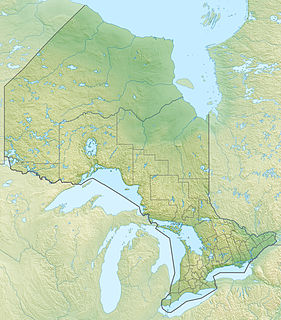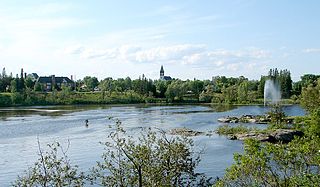| Shebandowan River | |
|---|---|
 | |
| Location | |
| Country | Canada |
| Province | Ontario |
| Region | Northeastern Ontario |
| District | Thunder Bay |
| Physical characteristics | |
| Source | Lower Shebandowan Lake |
| ⁃ location | Conacher Township |
| ⁃ coordinates | 48°37′11″N90°03′45″W / 48.61972°N 90.06250°W |
| ⁃ elevation | 449 m (1,473 ft) |
| Mouth | Matawin River |
⁃ location | Horne Township |
⁃ coordinates | 48°32′56″N89°53′27″W / 48.54889°N 89.89083°W Coordinates: 48°32′56″N89°53′27″W / 48.54889°N 89.89083°W |
⁃ elevation | 366 m (1,201 ft) |
| Basin features | |
| River system | Great Lakes Basin |
| Tributaries | |
| ⁃ left | Oskondaga River |
The Shebandowan River is a river in Thunder Bay District in Northwestern Ontario, Canada. [1] It is in the Great Lakes Basin and is a left tributary of the Matawin River. Three-quarters of the length of the river valley is paralleled by Ontario Highway 11, at this point part of the Trans-Canada Highway; and the entire length of the river valley is paralleled by a Canadian National Railway main line, built originally as the Canadian Northern Railway transcontinental main line.

A river is a natural flowing watercourse, usually freshwater, flowing towards an ocean, sea, lake or another river. In some cases a river flows into the ground and becomes dry at the end of its course without reaching another body of water. Small rivers can be referred to using names such as stream, creek, brook, rivulet, and rill. There are no official definitions for the generic term river as applied to geographic features, although in some countries or communities a stream is defined by its size. Many names for small rivers are specific to geographic location; examples are "run" in some parts of the United States, "burn" in Scotland and northeast England, and "beck" in northern England. Sometimes a river is defined as being larger than a creek, but not always: the language is vague.

Thunder Bay District is a district and census division in Northwestern Ontario in the Canadian province of Ontario. The district seat is Thunder Bay.

Northwestern Ontario is a secondary region of Northern Ontario which lies north and west of Lake Superior, and west of Hudson Bay and James Bay. It includes most of subarctic Ontario. Its western boundary is the Canadian province of Manitoba, which disputed Ontario's claim to the western part of the region. Ontario's right to Northwestern Ontario was determined by the Judicial Committee of the Privy Council in 1884 and confirmed by the Canada Act, 1889 of the Parliament of the United Kingdom. In 1912, the Parliament of Canada by the Ontario Boundaries Extension Act gave jurisdiction over the District of Patricia to Ontario, thereby extending the northern boundary of the province to Hudson Bay.





